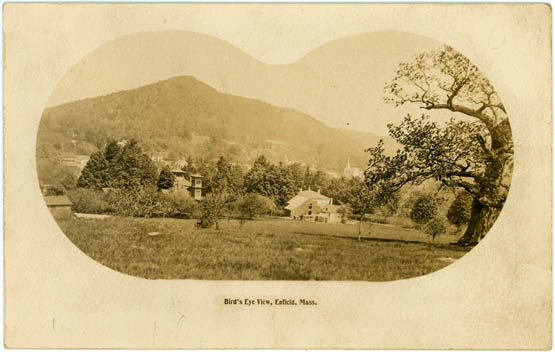Background on Enfield, Mass.

Bird's eye view of Enfield, ca.1910
Situated at the confluence of the east and west branches of the Swift River in western Massachusetts, Enfield was the largest and southernmost of the four towns inundated to create the Quabbin Reservoir. Laid out in June 1787 as the South Parish of the town of Greenwich, Enfield was officially incorporated from parts of Greenwich and Belchertown on Feb. 18, 1816, and named in honor of one of its early settlers, Robert Field.
With a population reaching nearly 1,100 by 1850, Enfield was the largest of the Quabbin towns and for most of its existence, it was the most prosperous in a generally impoverished region. While agriculture remained the primary source of income for most residents, it was also the site of an early grist mill and whetstone production, and by the 1820s, it was home to the Swift River Valley's only printers, Solomon and John Howe. The relative abundance of water power from the Swift River promoted manufacturing too, resulting in a flourishing of textile mills (cotton and wool) and the manufacture of wood products, leather goods (including boots and shoes), shingles, pearl buttons, and palm-leaf hats. Smith's Village, the upper of two villages in Enfield, was virtually a company town for the Swift River Company, a textile manufacturer, which operated there from 1821-1935, while the Minot Manufacturing Company chartered a woolen mill in the lower village in 1837. A spur of the Boston and Albany Railroad (the "Rabbit Run") was built through Enfield in 1871 connecting the town to Athol to Greenwich, New Salem, and Athol to the north and to Springfield to the South.
Like other towns in the Swift River Valley (Dana, Greenwich, and Prescott), Enfield's fortunes declined sharply after the turn of the twentieth century. Confronted with a critical demand for water in the Boston metropolitan region in 1895, the Commonwealth authorized the new Metropolitan Water District to seek new supplies in the western parts of the state. Construction of the Wachusett Reservoir along the Nashua River (1897-1908) bought time, but ultimately failed to meet projected demand, and by 1922, the MWD officially signaled its intention of damming the Swift River Valley, signifying an end to habitation there. All residents were ordered removed from the valley, with homes, farms, and places of business systematically destroyed, the land cleared, and graves removed.
Work on the Quabbin Reservoir began in 1926 with construction of the Ware River Diversion, a tunnel connecting the Wachusett Reservoir with the Ware River, followed in 1936 by construction of the Goodnough Dike and Windsor Dam. After the town's official disincorporation on April 28, 1938, the above-water portions of Enfield were annexed to nearby Belchertown, New Salem, Pelham, and Ware. On Aug. 14, 1939, the reservoir began to fill.

